Training Courses
Training courses is where you manage all your company, CASSA, and client training courses.
- Click on Training Courses and you’ll be taken to the training courses dashboard. You will see the following:
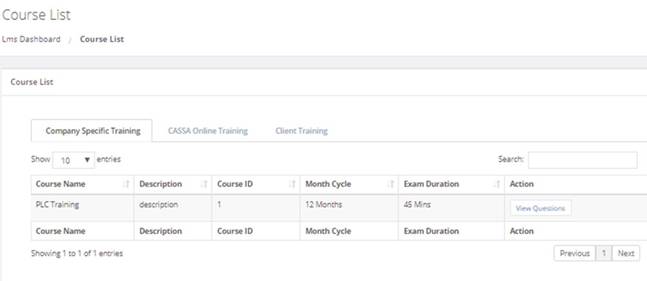
Your training courses list
As you can see from the image above, we have 3 tabs:
As the Company Specific Training tab is selected by default, we’ll look at that first.
Company Specific Training
Company Specific Training is your own company’s training that you create yourself (more details are in the next section, Course Setup).
It’s also the default tab when you click on Training Courses and the dashboard displays. You will see the following:
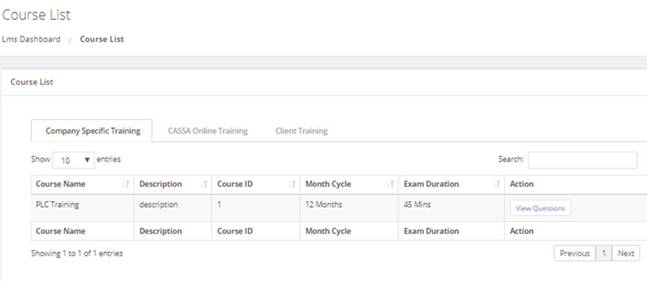
This tab shows your company specific training - the training that you've created yourself
As you can see, listed are the course(s) that you have created. In this case, there’s only 1 course, and you can see the following information/column headings:
- Course Name
- Description
- Course ID
- Month Cycle
- Exam Duration
- Action
With the exception of the Action field/column, the course attributes (the values in the columns) are created when you create your own course in Course Setup > Create Course. We’ll look at that in more detail when we get to that part of the help system.
Here, on the Company Specific Training tab, you can perform the following functions:
- View Questions – click on the Actions button to view this courses’ questions.
- Search for a Record
View Questions
Clicking on View Questions will display the following:
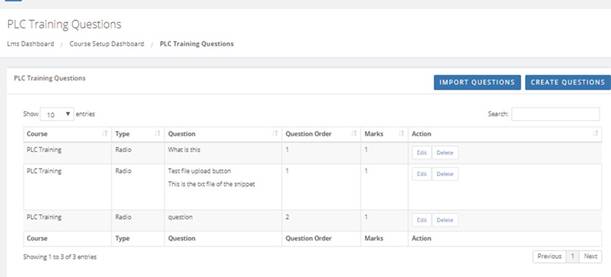
Here's where you view your questions
As you can see from the image above, we can see the following fields:
- Course Name – in this instance, it’s PLC Training Questions
- The question grid, including the following fields:
- Course – you can add multiple courses to CASSA
- Type –this is the answer type. The answer will be one of either: Single answer/radio, Multi Answer, Embedded a Video, or Audio,
- Question – the question that the testee must answer
- Question Order –
- Marks – different questions can have a different ‘weight’ applied to them,e.g.. a question with multiple answers may earn more marks than one with a single answer
- Action – the actions that you can take with the selected question. Here, we can see we have the Edit and Delete buttons
- Import Questions button
- Create Questions button
- Search for a Record field
Edit a Question
To edit a question:
-
In the training questions grid, identify the question that you wish to edit and click on the corresponding Edit button .
-
The question will open for editing:
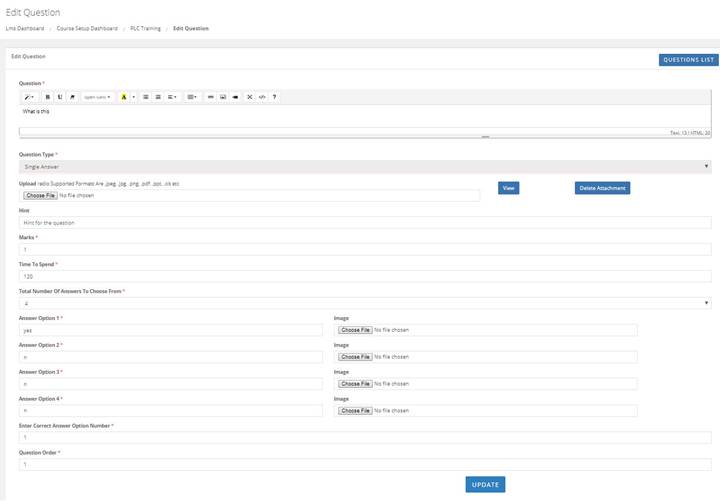
The edit question form
As you can see, there’s a fair bit going on here, but if you imported your questions (as per Import questions), then these will be familiar to you. If not, then follow along:
- Questions List button – click here to return to the questions list on the previous screen (the training questions screen)
- Question* – a required field, this is where you edit the question itself. It’s what’s called a Rich text editor field, which means that you can format your question in a number of ways. This is a standard-html editor and it’s beyond the scope of this help to walk you through it.
- Question Type* – The type of question. This is a required field and is read-only on this screen, and will be one of either: Single answer/radio, Multi Answer, Embedded a Video, or Audio.
- Upload file – here you can upload an image to be used as part of the question. The supported file types are jpeg, jpg, png, pdf, ppt, xlsx, docx
- Hint – if you want to provide a hint for your user, then you can enter that here to help them.
- Marks*– different questions can have a different ‘weight’ applied to them,e.g. a question with multiple answers may earn more marks than one with a single answer
- Time to Spend*– the allotted time for this particular question.
Allotting similar time when creating courses
When creating courses, where possible, it’s a good idea to allocated similar question types the same length of time, otherwise the testee might spend more time clock-watching than answering questions. After all, the purpose of these questions is to test not to trick.
- Total Number of Answers to Choose From*– this is the number of possible answers that they can choose from. This is a dropdown list, and the number of answer options available to fill in, will match the number selected here.
- Answer Options* – the number of answer options will match the total number of answers to choose from, which was selected, above. Here you can add a text answer to the field and a corresponding image.Square images work best here.
Once you’ve added your answer options:
- Enter Correct Answer Option Number* – here you select which one of the answer options from above is the correct answer.
- Question Order* – this determines where the question will appear in the quiz, i.e. if you want it to be the 7th question, add the number 7 here.
- Once you’ve finished editing your question, click on the Update button and any changes will be saved, and you’ll be returned to the
Delete a Question
To delete a question:
- Identify the question that you want to delete.
- Click on the Delete button and the following message will display:
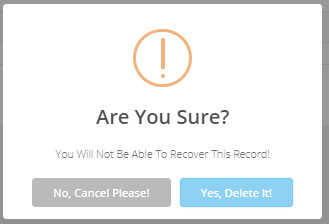
Whenever you delete something important, you'll need to confirm deletion
- Click on Yes, Delete It! to delete the question, or on No, Cancel Please, to return to the grid.
Import Questions
Adding questions 1 at a time to the CASSA interface is doable, but it isn’t the fastest method. The fastest way is to create the questions in a spreadsheet and then import the file into the system. That way, not only do you have an offline record of your own questions and courses, but you can also use it as a template to create additional courses, easily modify it, and so on.
- To get started, click on the Import Questions button:
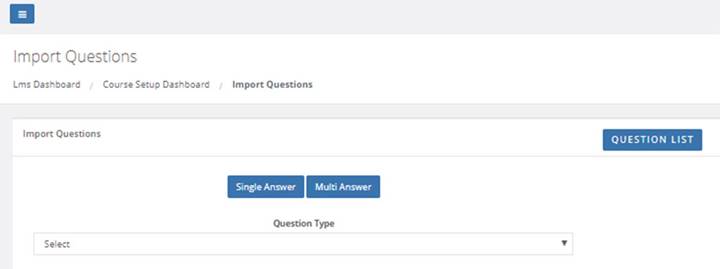
Creating your questions offline and importing them is the best way to create your courses
You can see that you have the Question List, Single Answer, and Multi Answer buttons, and the Question Type dropdown list.
2. Click on the Question List button to return to the main questions page
3. Click on the Single Answer button to download a spreadsheet for single answer questions (questions_radio_template.xlsx)
4. Click on the Multi Answer button to download a spreadsheet for multi answer questions (questions_radio_template.xlsx)
5. Click on the Question Type dropdown and select from either Single Answer or Multi Answer to display the Choose File button, where you can upload and import the corresponding question spreadsheet:
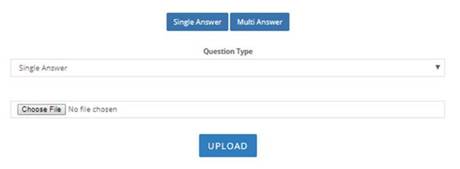
Select your answer type
- Click on the Choose File button and navigate to and select your spreadsheet.
- Click on the Upload button to initiate the import.
- The spreadsheet will import, and the questions added. You will see the success message, Successfully imported Questions!, and be taken to the Courses page.
- Single Answer
- Multiple Answer
- Question Type
Create Questions Using the Spreadsheet
To create questions using the spreadsheet, you will have needed to have downloaded the spreadsheet to your pc.
For the most part, the 2 spreadsheets are essentially the same. I’ll cover the differences at the appropriate time
However, before we even get to filling in the spreadsheet, we need to a little planning.
Planning
Filling in the spreadsheet and uploading it to CASSA is really easy, but there are a few guidelines to making it all as smooth as possible:
-
Plan your course, i.e. what’s the aim, what will the get out of it, what you’re actually going to achieve with the course. Having a clear objective is essential, otherwise the course may be too broad and try to cover too many things.
-
Decide how long your course is going to be. This could be 10 questions, 20 questions, and so on. The number of questions will be determined by your actual course objectives and what they need to do to achieve them.
-
Think about the types of questions you’re going to ask. Yes, these are single answer questions, but what format will the question take? Is it a text question (a written question)? Is it a video, a pdf document that they need to read first to answer?
-
How long will they get for each question? Do all questions of the same type, such as text-questions, get the same length of time? The purpose of a training course is to get them to display their level of knowledge, not to be tricked into running out of time. So, give them what they need.
-
Do all questions and answers carry the same weight? Some questions may be more important, more complex, or require greater thought than others. So, do these acquire more marks if they get them right?
-
Also, with your questions, do you want to provide a hint, so they can get a little nudge in the right direction if they can’t come up with the correct answer?
-
Be careful of ambiguous questions or multiple answers. The former is never a good idea and, though multiple answers can and do work, they don’t in a single answer formatted question/answer test.
Populating the Spreadsheet
To populate the spreadsheet
-
Open the single answer spreadsheet (questions_radio_template.xslx). The assumption is that you know a little bit about Excel. If you don’t, I can only suggest asking someone to help you fill the spreadsheet in. It’s not complicated, but it’ll make it easier for you.
-
Click on File and then on Save As. Save the spreadsheet with your course name, etc. When done, this will take you to the spreadsheet:

Your Excel spreadsheet for creating questions
- As you can see, we have the following columns:
- question_type – all questions are radio type and every single question you enter must have ‘radio’ in this column. If you miss one, that question/row will not be imported
- question_order – this is the number order that the questions will be listed in, once imported. If you already have questions in your course, then make sure the numbers here follow on from those in your course and they will be appended to your course, rather than overwriting them.
For example, if your course already has 3 questions in, then numbering these new questions 4+ will ensure that they aren’t overwritten.
Note: our suggestion is to use 1 spreadsheet/document for 1 course and to keep all your questions for that course in that spreadsheet. This makes it easier to manage and track and will avoid accidentally overwriting existing questions and so forth.
- question – this is the actual question itself. Please insert all required punctuation.
- marks – the number of points or marks awarded for correctly answering this question
- time_to_spend_secs – the length of time (in seconds) they have to answer the question
- hint – if you want to provide a clue to help jog their memory, then enter that here
- total_answers – the total number of answers to this question
- correct_answer – which of the answers here is correct
- answer1, answer2, answer3-x – these are the actual answers you need to provide. The number of answers you provide must match the number given in total_answers, above. If it’s incorrect, or you have a blank answer, then the question will not be imported.
- If you need to add multiple columns to add additional answers, that is permissible.
- If you add additional columns for extra answers, e.g. answer5 and answer6, you do not need to provide additional answers for questions that only have 4 answers or less – as long as the value in total_answers for that question matches the correct number of answers.
- course_id – this is the ID of the course these questions will be added to. It’s found on the main grid (and other areas where the course is listed):
image011
Good Import Sample
So, let’s look at a ‘good import’ sample:

Ensure your spreadsheet is setup correctly prior to importing it into the system
Here you can see:
- Every row/question has radio in column A.
- Not every field is filled out, but the important, required fields are.
- Row 2 and 3 both have answer5 filled in (column M) filled in, but the question in row 2 only has 4 answers (answer1-answer4) – as long as the number of answers (answer1, columns I; answer2, column J; answer3, column K, etc.) is greater or equal to the value in total_answers then this will work.
- You’ll note in column B that I’ve jumbled the order of the questions. This was because this image was taken during testing. However, Excel will let me sort these in order, and that’s what I would recommend that you do:
1.Click in cell B1.
2.Click on Home > Editing > Sort & Filter > Custom Sort
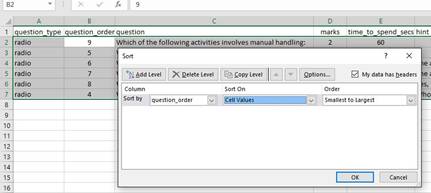
Excel has some very powerful features. The ability to custom sort is one of them.
- Sort based on Cell Values and Smallest to Largest and click on Ok. They’ll be sorted neatly in order:
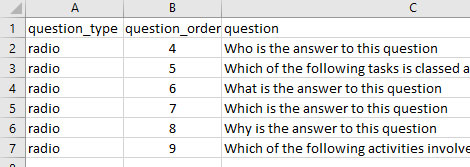
Your list sorted by question order
We recommend using the spreadsheet
Again, we recommend that you list all questions in the spreadsheet. So, your sheet will include questions 1, 2, and 3. This will make it easier to manage in the long-term. The above is just for illustrative test purposes and taken during testing.
- When the spreadsheet has imported, you can view the questions:
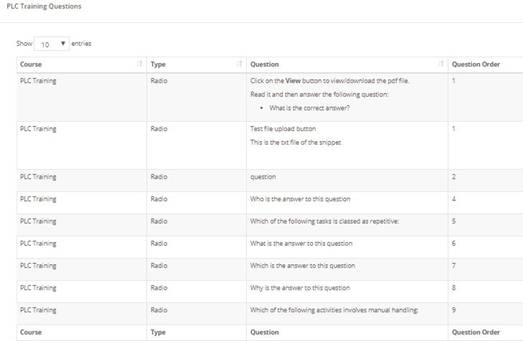
This is how your imported questions will look
Bad Import Sample
Now let’s look at a bad import sample. I’ve duplicated the image below, so you can clearly see what’s amiss in the top, uncluttered version:
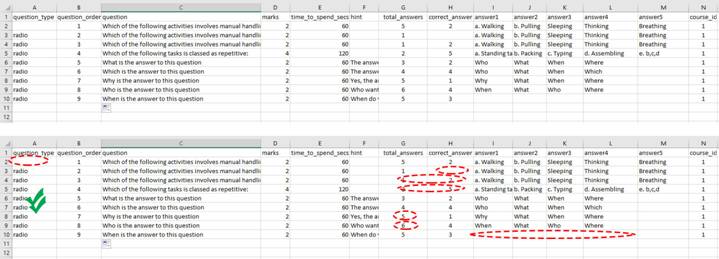
Here we look at a good and bad sample
Only rows 6 and 7 are good samples here – they’re the only rows that CASSA will import. Yes, row 6 has 4 answers listed (answer1-answer4), but this is allowed because column G, total_answers, states there are only 3 answers for this question.
Let’s look at why the other questions will not be imported:
- Row 2 – cell A2 is blank. It needs to have ‘radio’ inserted there, the same as the cells below it.
- Row 3 – despite having total_answers and answer1-answer5, there is no correct_answer listed, so this will fail.
- Row 5 – this will fail because the correct_answer is shown as 5, but there are only 2 total_answers. The correct_answer value has to be ≤total_answers (less than or equal to total_answers).
- Row 8 – will fail because though 5total_answers are specified, there is no answer5 (cell M5 is blank).
- Row 9 – will fail for 2 reasons: we have 6 in the total_answers cell, but though there is an answer5, it’s blank, and there is no answer6 column.
- Row 10 – this fails because no answers have been given.
This list is not exhaustive, but it shows the common errors that are made when importing questions.
Multi Questions Spreadsheet
Now let’s take a look at the Multi Answers spreadsheet:

The multi answers spreadsheet is slightly different
The only differences between the Single Answer spreadsheet and the Multi Answer spreadsheet are:
- Column A must have the word checkbox instead of radio: radio buttons allow single answers, checkboxes allow multiple answers.
- total_correct_answers (columnH) can be ≥1 (and ≤answer1-answerx)
- correct_answer can have more than 1 answer, comma-delimited (this means separated by a comma)
The other fields are the same.
Things to Watch Out For
- A cell in column A is blank or has checkbox spelt incorrectly.
- The total_correct_answers value is less than or equal to the number of answers listed. As in the Bad Import Sample, row 5.
- The correct_answer value(s) do not correspond to answer1, answer2… and there is a blank field.
These are the most common errors.
Create Questions
If you want to add questions individually, modify existing questions (if you want to add images to them) or you want to add a video or an audio question, then you can use the create question function,
- Click on the Create Question button and the create question form will display:
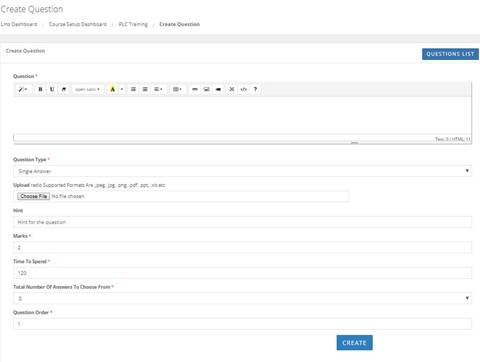
The CASSA create question form
As you can see, there’s a fair bit going on here, but it’s quite straightforward:
- Questions List button – click here to return to the questions list on the previous screen (the training questions screen)
- Question – a required field, this is where you edit the question itself. It’s what’s called a Rich text editor field, which means that you can format your question in a number of ways. This is a standard-html editor and it’s beyond the scope of this help to walk you through it.
- Question Type * – The type of question. This is a required field and is read-only on this screen, and will be one of either: Single answer/radio, Multi Answer, Embedded a Video, or Audio.
- Upload file – here you can upload an image to be used as part of the question. The supported file types are jpeg, jpg, png, pdf, ppt, xlsx, docx
- Hint – if you want to provide a hint for your user, then you can enter that here to help them.
- Marks – different questions can have a different ‘weight’ applied to them,e.g. a question with multiple answers may earn more marks than one with a single answer
- Time to Spend – the allotted time for this particular question.
Allotting similar time when creating courses
When creating courses, where possible, it’s a good idea to allocated similar question types the same length of time, otherwise the testee might spend more time clock-watching than answering questions. After all, the purpose of these questions is to test not to trick.
- Total Number of Answers to Choose From – this is the number of possible answers that they can choose from. This is a dropdown list, and the number of answer options available to fill in, will match the number selected here. When you select this option, the next 2 fields will display:
- Answer Options – the number of answer options will match the total number of answers to choose from, which was selected, above. Here you can add a text answer to the field and a corresponding image. Square images work best here.
- Enter Correct Answer Option Number – here you select which one of the answer options from above is the correct answer.
- Question Order – this determines where the question will appear in the quiz, i.e. if you want it to be the 7th question, add 7. If this number is already taken/in use, then the original question will not be overridden. It will be appended to the list of those with the same order number:

Edit question
- Once you’ve added your information, click on the Create button and the question will save, the screen will refresh, and your question will be added to the list of questions for that course.
Search for a Record
The search functionality has been documented a number of times already, refer to Search for a Record for further details.
CASSA Online Training
As part of the CASSA system, we’ve also added some training that you can use.
- Click on the CASSA Online Training tab to see what training is available:

The CASSA Online Training tab
Of course, if you’re new to CASSA, there’s a good chance that the training grid is empty:

An empty CASSA Online Training grid
If this is the case, we’ll add some CASSA online training courses.
- Click on Marketplace in the main navigation and the Marketplace dashboard will display:
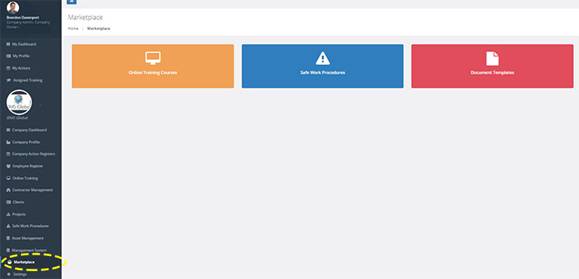
Your marketplace dashboard
- Click on Online Training Courses and the available courses grid will show:

The courses available to you will be shown here
-
Now you can scan through the list of courses and, if you want to take 1 or more of the courses, click on the correspond Add Course
-
For the purposes of this demo, I‘ll add the top 3 in the list: Environmental Training, Quality Management System Training, and Hand Held Power Tools. (Of course, you can and will add them all.)
-
As soon as I click to add a course, the button changes to show me the course has been added:
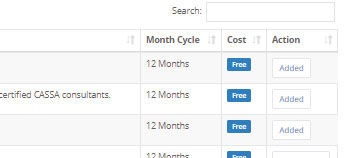
This is what you'll see once the courses have been added
- Now, return to Online Training >Training Courses > CASSA Online Training and you’ll see the courses have been added:

Courses added to the list
From here you can:
You will want to assign these courses to your staff, and we cover this in Assign Course to Role.
Delete Course
To delete a course:
- Identify the course you wish you delete
- Click on the Delete Course button and you will see a confirmation dialog. Click on Yes to confirm and delete the course from your training or No to cancel and return to the tab.
Search for a Course
You can also use the Search facility to locate a course. The search functionality has been documented extensively elsewhere, so click here to view how to use the search facility.
Client Training
The client training tab will list any training that’s been assigned to your contractors. This functions in a similar way to the Company Specific Training.
Updated almost 5 years ago
